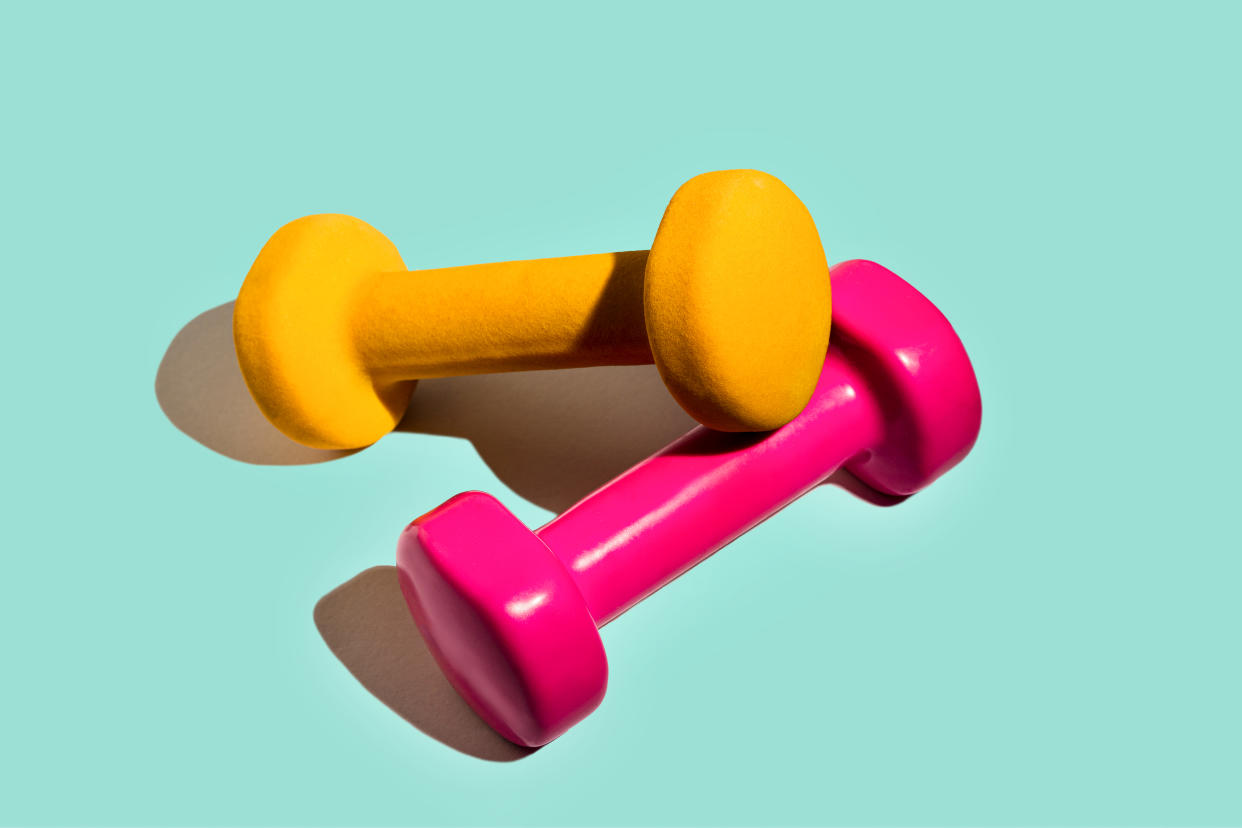Resistance training is so important as you age. How to get started with weight exercises — because it's never too late.

When you picture your older self, do you imagine you’ll slow down or stay active? If it’s the latter, it’s never too early to start putting the work in now. Maintaining an active lifestyle as we age is crucial for preserving physical health, mental well-being and overall quality of life. Taking walks and enjoying other forms of cardio-based activity (pickleball, anyone?!) is a good start — and important for maintaining everything from our heart health to our weight — but there’s one thing experts don’t want overlooked: resistance training.
Resistance training is a broad term for exercises in which you work against some form of weight or resistance. Experts agree that strengthening your muscles through this type of training is a must-do as you age — but you don’t necessarily need to pump iron in the gym to reap the benefits. This weight can come from free weights, barbells, exercise machines, resistance bands or even your own body weight.
Here’s what to know — and how to get started.
Why we need to think about resistance training as we age
As we get older, it’s important for us to maintain our strength, balance and mobility in order to stay independent. However, we naturally lose muscle mass with age, which can create problems for us down the road, Dr. Danielle Ponzio, an orthopedic surgeon with Rothman Orthopaedic Institute at AtlantiCare, tells Yahoo Life.
Geriatric kinesiologist Mercedes Fernandez tells Yahoo Life that the human body needs to have strong muscles because it “creates stability within the skeletal system and maintains bone density.”
“Our bones are connected by tendons, ligaments and muscles,” Fernandez explains. “When our muscles are weak, there is a higher risk to the stability of the skeletal system. There are more chances for injury and immobility as the muscular system that protects joints and facilitates movement diminishes.”
In short: The weaker our muscles are, the less we move. And the less we move, the more we stiffen up.
So, what can we do about it? Ponzio says that weight-bearing exercises, aka resistance training, help us maintain and even build muscle mass, while also improving bone quality and bone mass.
When you resistance train, it puts pressure on your bones, which triggers your body to build new bone tissue. At the same time, resistance training causes tiny tears in your muscles, which your body then repairs, making your muscles stronger in the process.
Resistance training, Ponzio says, can help prevent conditions such as osteoporosis, which causes bones to become weak and brittle, and reduce the risk of fractures. Resistance training also helps make joint conditions including arthritis — which is inflammation and stiffness in the joints — less symptomatic. All of this helps us move more and remain more comfortable doing so.
How to get started with resistance training
One popular form of resistance training is lifting weights. You can start at home with just a few weights, or join a gym with more equipment on hand. An easy approach is to start with weights you can comfortably lift between eight and 12 times in a single set of exercise, and repeat that three times.
Lance Johnson, a personal trainer and ARORA-certified coach at Life Time, says for beginners, it’s best to go with lighter weights to avoid injuries and build strength at a comfortable pace. Dumbbells are a good choice because they’re easier to handle than barbells and provide more control. Some exercises you can try include dead lifts, bench presses and squats.
If you’re new to exercising, dealing with injuries or have physical limitations, Johnson recommends consulting a professional trainer to ensure you’ve got the correct form and intensity.
Lifting weights isn’t for me. What are some other options?
Not comfortable pumping iron in the gym? Fernandez says that there is “a lot of value in low-impact strength training that doesn’t require lifting weights.” This includes using just your body weight with moves including push-ups, squats, lunges and planks. You can also add a resistance band — squats with a band just above the knees are a popular choice — to make these exercises even more challenging.
If you want to move beyond basic body weight exercises, Ponzio suggests Pilates. This low-impact exercise method, which can be done on a mat or a Reformer machine, focuses on controlled movements and aims to improve flexibility, balance and core strength.
The bottom line
No matter what exercise you are doing for resistance training as you age, you need to go at the pace that’s appropriate for you. This is especially true for older adults. Dr. Danielle Kelvas of the HCG Institute tells Yahoo Life that she typically sees an older individual go from being mostly sedentary to “suddenly picking up a rigorous exercise routine” — which can be a recipe for disaster.
“You have to step into this slowly, otherwise you end up with strains and sprains and weeks of physical therapy,” she says. Though Pilates is a good choice for older adults, she says that often, people will go to class, “overdo it and push to keep up with everyone and end up injuring themselves.” Make sure to speak with your instructor about any potential limitations, and always stop a movement if you feel any pain.
If you want to start resistance training but feel unsure where to start or where your limits are, you can seek out a certified personal trainer, who can help create a safe routine. You should also speak to a doctor about starting any new exercise routine.


